Southern Cross University MNG81001: Executive Summary on Leadership
VerifiedAdded on 2021/12/16
|8
|1327
|51
Report
AI Summary
This assignment is an executive summary exploring corporate communication strategies employed by leaders in the 21st century. The report begins with an introduction that establishes the importance of communication as a crucial managerial function, emphasizing its role in building successful public relations. It then discusses leadership behaviors based on market insights and consumer behavior, followed by the Leaders Educate/Inspire/Reinforce framework for delivering information. The summary highlights the importance of effective superior-subordinate communication and the use of simple yet meaningful messages to inspire teams. The report incorporates insights from various sources, including quotes from influential figures like James Humes, Thomas Boone Pickens, Gilbert Amelio, and Lee Lacocca, to support its arguments. The conclusion emphasizes the shift towards a more strategic focus in leaders' communication strategies and the necessity for leaders to equip their subordinates with the necessary skills. The report includes references to academic articles and journals to support the analysis.
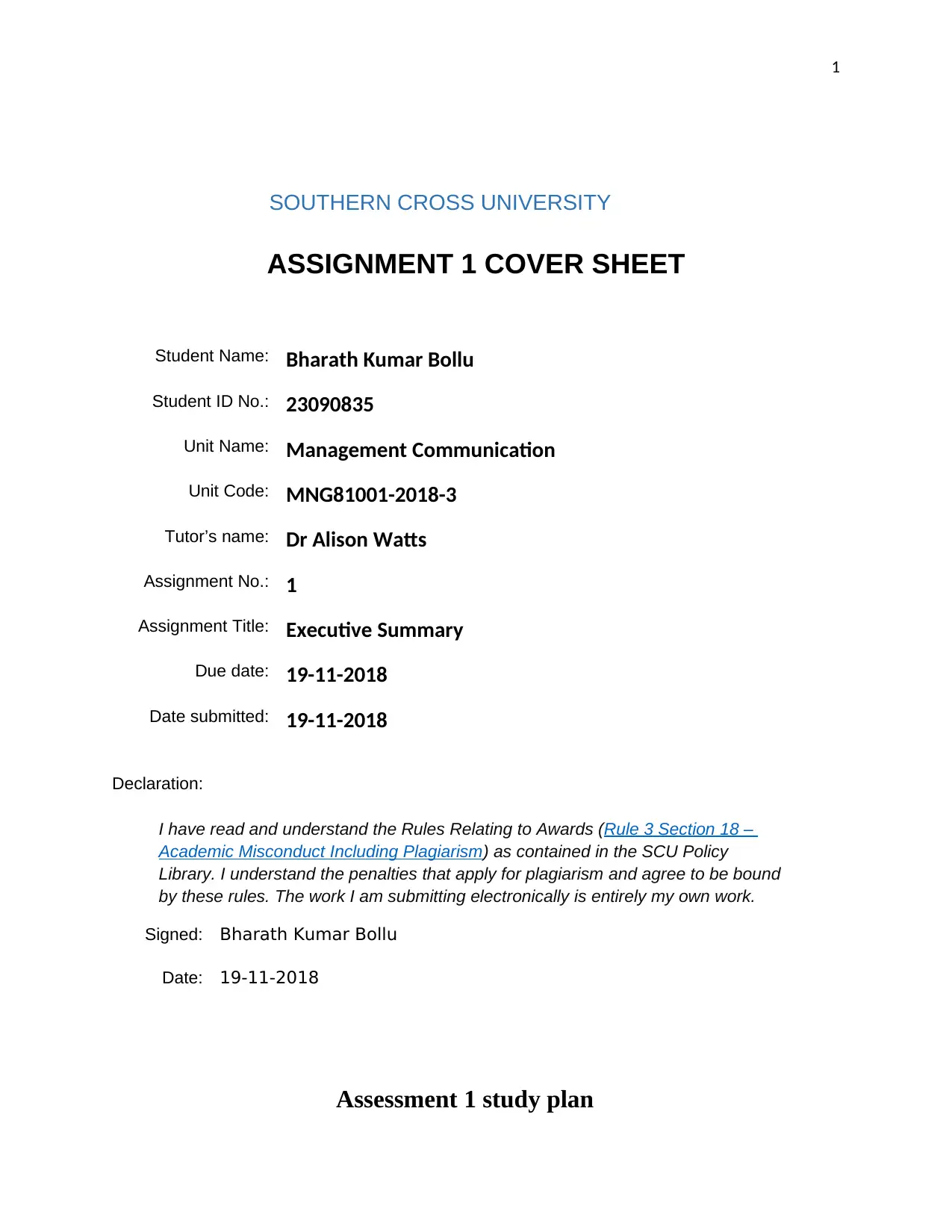
1
SOUTHERN CROSS UNIVERSITY
ASSIGNMENT 1 COVER SHEET
Student Name: Bharath Kumar Bollu
Student ID No.: 23090835
Unit Name: Management Communication
Unit Code: MNG81001-2018-3
Tutor’s name: Dr Alison Watts
Assignment No.: 1
Assignment Title: Executive Summary
Due date: 19-11-2018
Date submitted: 19-11-2018
Declaration:
I have read and understand the Rules Relating to Awards (Rule 3 Section 18 –
Academic Misconduct Including Plagiarism) as contained in the SCU Policy
Library. I understand the penalties that apply for plagiarism and agree to be bound
by these rules. The work I am submitting electronically is entirely my own work.
Signed: Bharath Kumar Bollu
Date: 19-11-2018
Assessment 1 study plan
SOUTHERN CROSS UNIVERSITY
ASSIGNMENT 1 COVER SHEET
Student Name: Bharath Kumar Bollu
Student ID No.: 23090835
Unit Name: Management Communication
Unit Code: MNG81001-2018-3
Tutor’s name: Dr Alison Watts
Assignment No.: 1
Assignment Title: Executive Summary
Due date: 19-11-2018
Date submitted: 19-11-2018
Declaration:
I have read and understand the Rules Relating to Awards (Rule 3 Section 18 –
Academic Misconduct Including Plagiarism) as contained in the SCU Policy
Library. I understand the penalties that apply for plagiarism and agree to be bound
by these rules. The work I am submitting electronically is entirely my own work.
Signed: Bharath Kumar Bollu
Date: 19-11-2018
Assessment 1 study plan
Paraphrase This Document
Need a fresh take? Get an instant paraphrase of this document with our AI Paraphraser
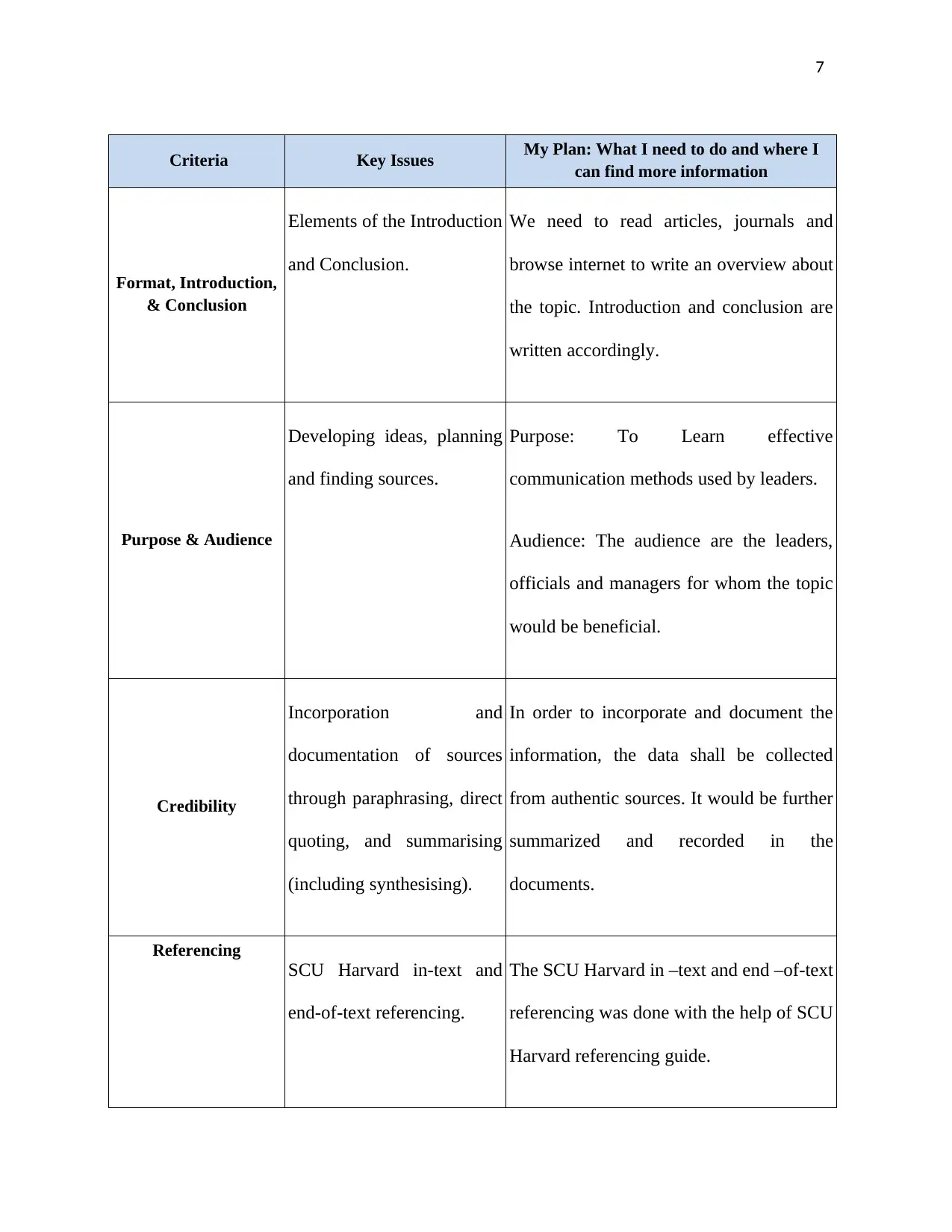
7
Criteria Key Issues My Plan: What I need to do and where I
can find more information
Format, Introduction,
& Conclusion
Elements of the Introduction
and Conclusion.
We need to read articles, journals and
browse internet to write an overview about
the topic. Introduction and conclusion are
written accordingly.
Purpose & Audience
Developing ideas, planning
and finding sources.
Purpose: To Learn effective
communication methods used by leaders.
Audience: The audience are the leaders,
officials and managers for whom the topic
would be beneficial.
Credibility
Incorporation and
documentation of sources
through paraphrasing, direct
quoting, and summarising
(including synthesising).
In order to incorporate and document the
information, the data shall be collected
from authentic sources. It would be further
summarized and recorded in the
documents.
Referencing
SCU Harvard in-text and
end-of-text referencing.
The SCU Harvard in –text and end –of-text
referencing was done with the help of SCU
Harvard referencing guide.
Criteria Key Issues My Plan: What I need to do and where I
can find more information
Format, Introduction,
& Conclusion
Elements of the Introduction
and Conclusion.
We need to read articles, journals and
browse internet to write an overview about
the topic. Introduction and conclusion are
written accordingly.
Purpose & Audience
Developing ideas, planning
and finding sources.
Purpose: To Learn effective
communication methods used by leaders.
Audience: The audience are the leaders,
officials and managers for whom the topic
would be beneficial.
Credibility
Incorporation and
documentation of sources
through paraphrasing, direct
quoting, and summarising
(including synthesising).
In order to incorporate and document the
information, the data shall be collected
from authentic sources. It would be further
summarized and recorded in the
documents.
Referencing
SCU Harvard in-text and
end-of-text referencing.
The SCU Harvard in –text and end –of-text
referencing was done with the help of SCU
Harvard referencing guide.
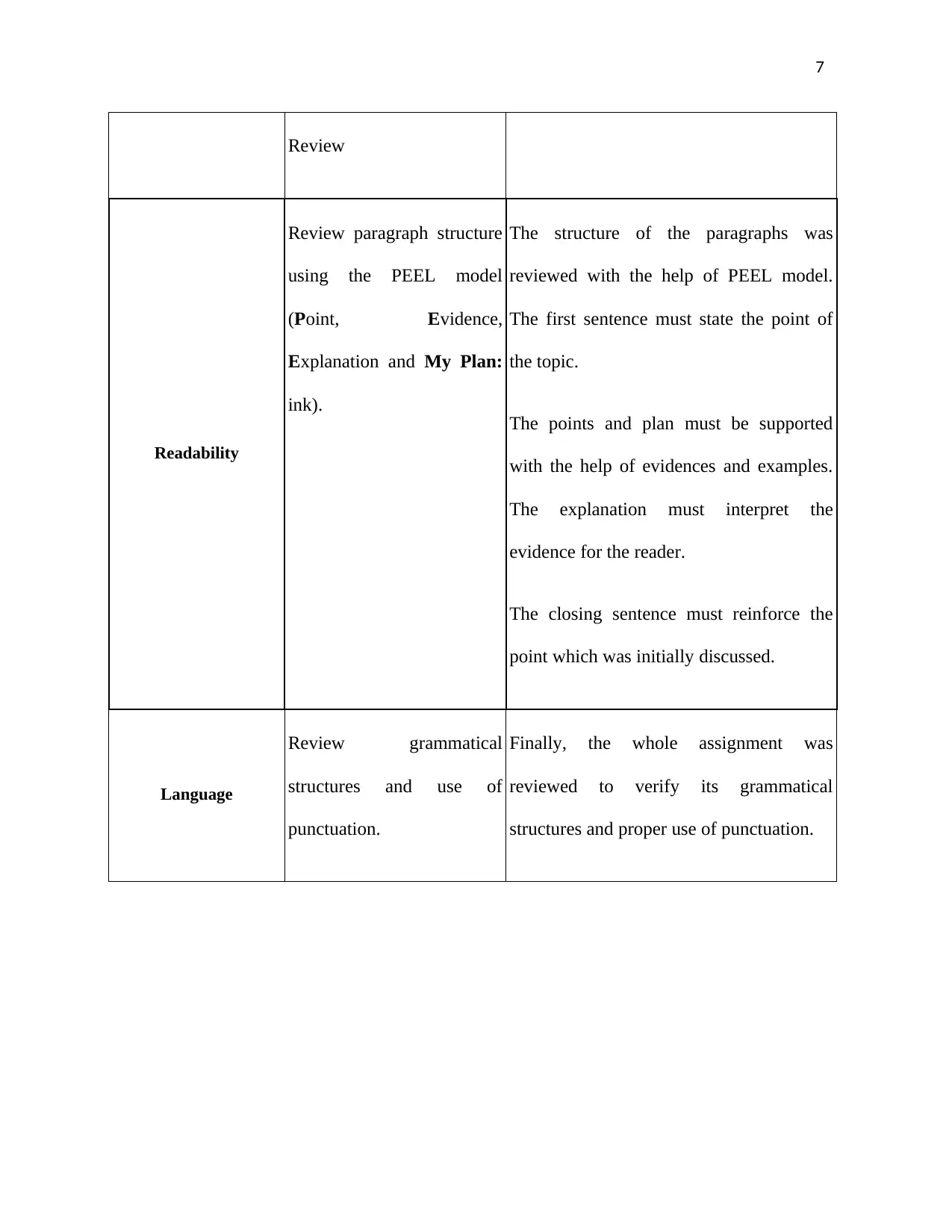
7
Review
Readability
Review paragraph structure
using the PEEL model
(Point, Evidence,
Explanation and My Plan:
ink).
The structure of the paragraphs was
reviewed with the help of PEEL model.
The first sentence must state the point of
the topic.
The points and plan must be supported
with the help of evidences and examples.
The explanation must interpret the
evidence for the reader.
The closing sentence must reinforce the
point which was initially discussed.
Language
Review grammatical
structures and use of
punctuation.
Finally, the whole assignment was
reviewed to verify its grammatical
structures and proper use of punctuation.
Review
Readability
Review paragraph structure
using the PEEL model
(Point, Evidence,
Explanation and My Plan:
ink).
The structure of the paragraphs was
reviewed with the help of PEEL model.
The first sentence must state the point of
the topic.
The points and plan must be supported
with the help of evidences and examples.
The explanation must interpret the
evidence for the reader.
The closing sentence must reinforce the
point which was initially discussed.
Language
Review grammatical
structures and use of
punctuation.
Finally, the whole assignment was
reviewed to verify its grammatical
structures and proper use of punctuation.
⊘ This is a preview!⊘
Do you want full access?
Subscribe today to unlock all pages.

Trusted by 1+ million students worldwide
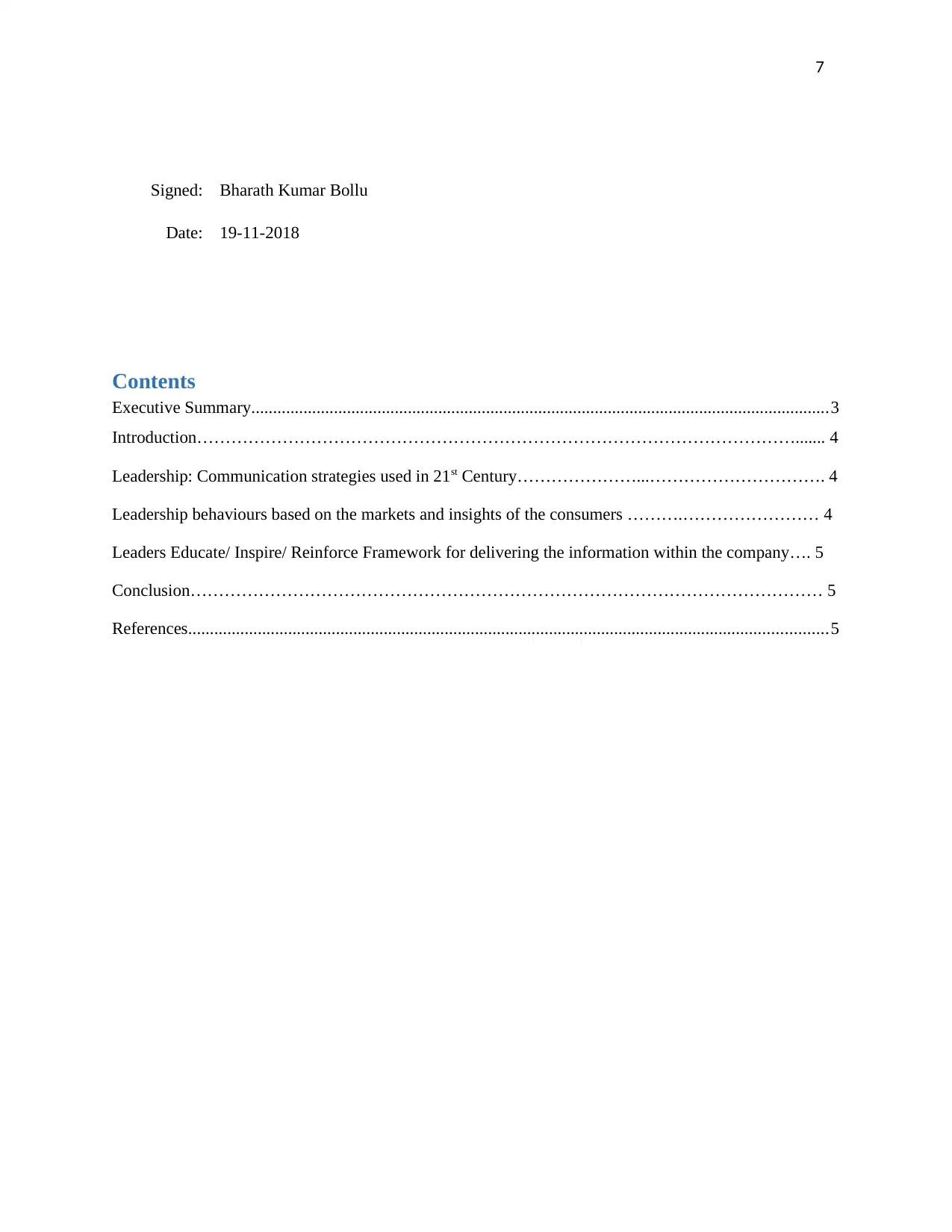
7
Signed: Bharath Kumar Bollu
Date: 19-11-2018
Contents
Executive Summary.....................................................................................................................................3
Introduction……………………………………………………………………………………………....... 4
Leadership: Communication strategies used in 21st Century…………………...…………………………. 4
Leadership behaviours based on the markets and insights of the consumers ……….…………………… 4
Leaders Educate/ Inspire/ Reinforce Framework for delivering the information within the company…. 5
Conclusion………………………………………………………………………………………………… 5
References...................................................................................................................................................5
Signed: Bharath Kumar Bollu
Date: 19-11-2018
Contents
Executive Summary.....................................................................................................................................3
Introduction……………………………………………………………………………………………....... 4
Leadership: Communication strategies used in 21st Century…………………...…………………………. 4
Leadership behaviours based on the markets and insights of the consumers ……….…………………… 4
Leaders Educate/ Inspire/ Reinforce Framework for delivering the information within the company…. 5
Conclusion………………………………………………………………………………………………… 5
References...................................................................................................................................................5
Paraphrase This Document
Need a fresh take? Get an instant paraphrase of this document with our AI Paraphraser
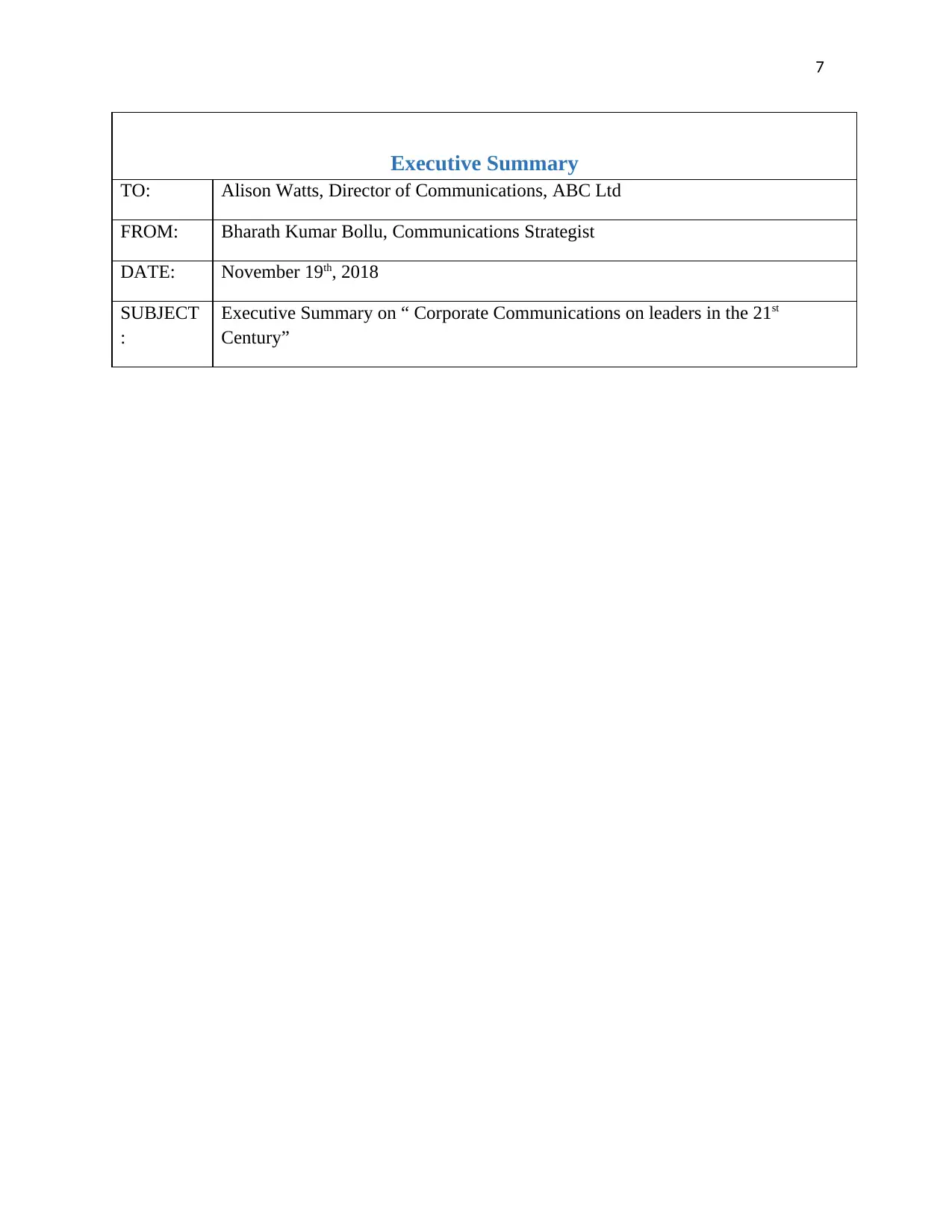
7
Executive Summary
TO: Alison Watts, Director of Communications, ABC Ltd
FROM: Bharath Kumar Bollu, Communications Strategist
DATE: November 19th, 2018
SUBJECT
:
Executive Summary on “ Corporate Communications on leaders in the 21st
Century”
Executive Summary
TO: Alison Watts, Director of Communications, ABC Ltd
FROM: Bharath Kumar Bollu, Communications Strategist
DATE: November 19th, 2018
SUBJECT
:
Executive Summary on “ Corporate Communications on leaders in the 21st
Century”
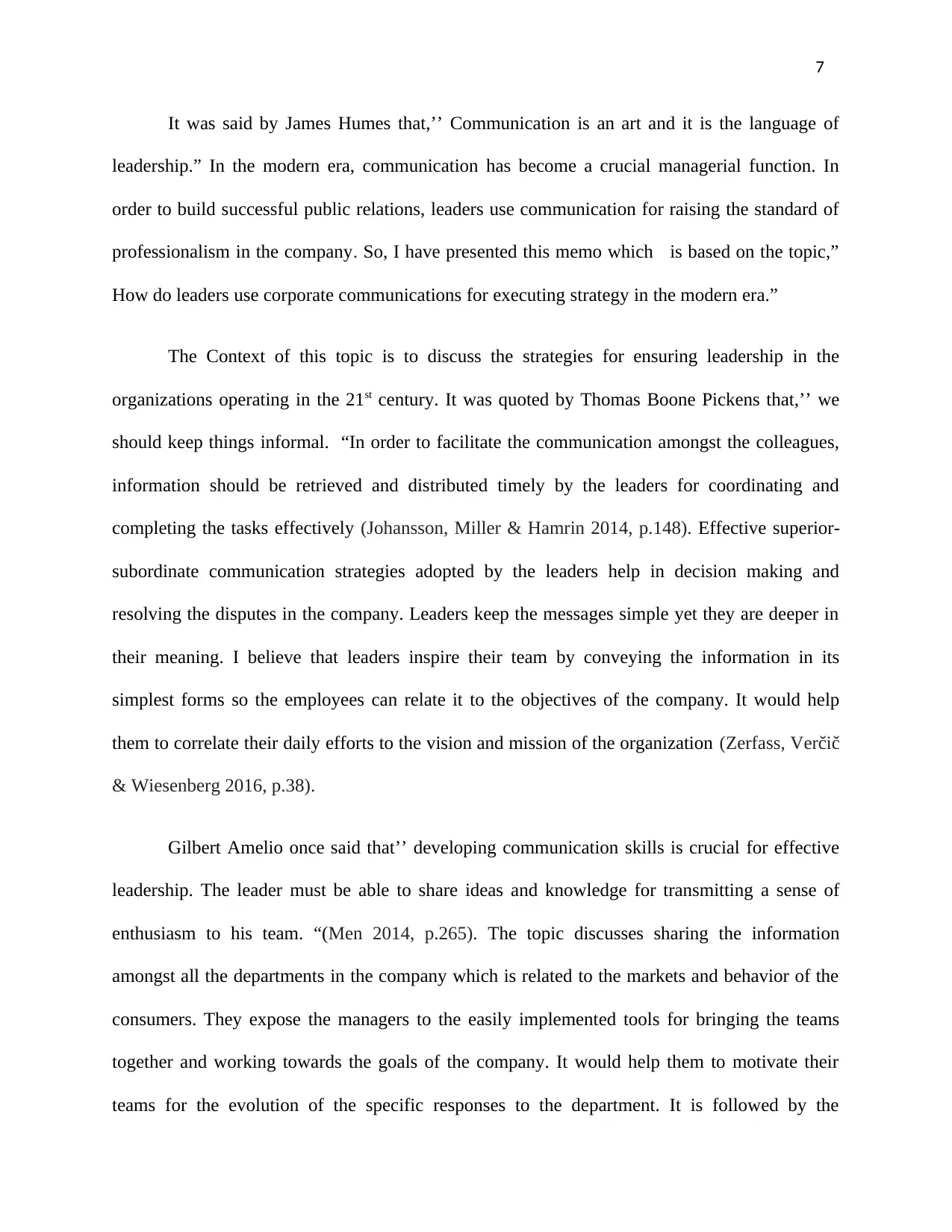
7
It was said by James Humes that,’’ Communication is an art and it is the language of
leadership.” In the modern era, communication has become a crucial managerial function. In
order to build successful public relations, leaders use communication for raising the standard of
professionalism in the company. So, I have presented this memo which is based on the topic,”
How do leaders use corporate communications for executing strategy in the modern era.”
The Context of this topic is to discuss the strategies for ensuring leadership in the
organizations operating in the 21st century. It was quoted by Thomas Boone Pickens that,’’ we
should keep things informal. “In order to facilitate the communication amongst the colleagues,
information should be retrieved and distributed timely by the leaders for coordinating and
completing the tasks effectively (Johansson, Miller & Hamrin 2014, p.148). Effective superior-
subordinate communication strategies adopted by the leaders help in decision making and
resolving the disputes in the company. Leaders keep the messages simple yet they are deeper in
their meaning. I believe that leaders inspire their team by conveying the information in its
simplest forms so the employees can relate it to the objectives of the company. It would help
them to correlate their daily efforts to the vision and mission of the organization (Zerfass, Verčič
& Wiesenberg 2016, p.38).
Gilbert Amelio once said that’’ developing communication skills is crucial for effective
leadership. The leader must be able to share ideas and knowledge for transmitting a sense of
enthusiasm to his team. “(Men 2014, p.265). The topic discusses sharing the information
amongst all the departments in the company which is related to the markets and behavior of the
consumers. They expose the managers to the easily implemented tools for bringing the teams
together and working towards the goals of the company. It would help them to motivate their
teams for the evolution of the specific responses to the department. It is followed by the
It was said by James Humes that,’’ Communication is an art and it is the language of
leadership.” In the modern era, communication has become a crucial managerial function. In
order to build successful public relations, leaders use communication for raising the standard of
professionalism in the company. So, I have presented this memo which is based on the topic,”
How do leaders use corporate communications for executing strategy in the modern era.”
The Context of this topic is to discuss the strategies for ensuring leadership in the
organizations operating in the 21st century. It was quoted by Thomas Boone Pickens that,’’ we
should keep things informal. “In order to facilitate the communication amongst the colleagues,
information should be retrieved and distributed timely by the leaders for coordinating and
completing the tasks effectively (Johansson, Miller & Hamrin 2014, p.148). Effective superior-
subordinate communication strategies adopted by the leaders help in decision making and
resolving the disputes in the company. Leaders keep the messages simple yet they are deeper in
their meaning. I believe that leaders inspire their team by conveying the information in its
simplest forms so the employees can relate it to the objectives of the company. It would help
them to correlate their daily efforts to the vision and mission of the organization (Zerfass, Verčič
& Wiesenberg 2016, p.38).
Gilbert Amelio once said that’’ developing communication skills is crucial for effective
leadership. The leader must be able to share ideas and knowledge for transmitting a sense of
enthusiasm to his team. “(Men 2014, p.265). The topic discusses sharing the information
amongst all the departments in the company which is related to the markets and behavior of the
consumers. They expose the managers to the easily implemented tools for bringing the teams
together and working towards the goals of the company. It would help them to motivate their
teams for the evolution of the specific responses to the department. It is followed by the
⊘ This is a preview!⊘
Do you want full access?
Subscribe today to unlock all pages.

Trusted by 1+ million students worldwide
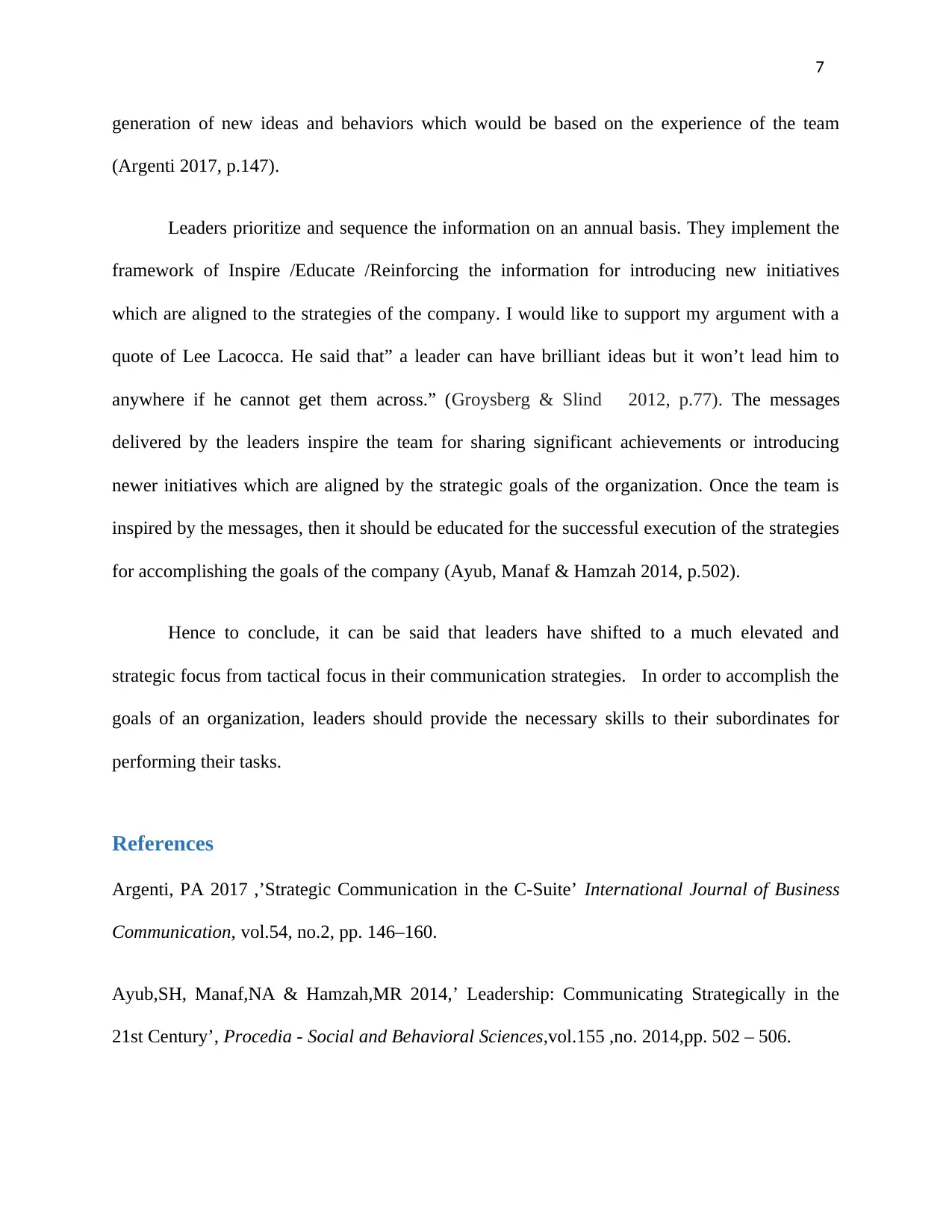
7
generation of new ideas and behaviors which would be based on the experience of the team
(Argenti 2017, p.147).
Leaders prioritize and sequence the information on an annual basis. They implement the
framework of Inspire /Educate /Reinforcing the information for introducing new initiatives
which are aligned to the strategies of the company. I would like to support my argument with a
quote of Lee Lacocca. He said that” a leader can have brilliant ideas but it won’t lead him to
anywhere if he cannot get them across.” (Groysberg & Slind 2012, p.77). The messages
delivered by the leaders inspire the team for sharing significant achievements or introducing
newer initiatives which are aligned by the strategic goals of the organization. Once the team is
inspired by the messages, then it should be educated for the successful execution of the strategies
for accomplishing the goals of the company (Ayub, Manaf & Hamzah 2014, p.502).
Hence to conclude, it can be said that leaders have shifted to a much elevated and
strategic focus from tactical focus in their communication strategies. In order to accomplish the
goals of an organization, leaders should provide the necessary skills to their subordinates for
performing their tasks.
References
Argenti, PA 2017 ,’Strategic Communication in the C-Suite’ International Journal of Business
Communication, vol.54, no.2, pp. 146–160.
Ayub,SH, Manaf,NA & Hamzah,MR 2014,’ Leadership: Communicating Strategically in the
21st Century’, Procedia - Social and Behavioral Sciences,vol.155 ,no. 2014,pp. 502 – 506.
generation of new ideas and behaviors which would be based on the experience of the team
(Argenti 2017, p.147).
Leaders prioritize and sequence the information on an annual basis. They implement the
framework of Inspire /Educate /Reinforcing the information for introducing new initiatives
which are aligned to the strategies of the company. I would like to support my argument with a
quote of Lee Lacocca. He said that” a leader can have brilliant ideas but it won’t lead him to
anywhere if he cannot get them across.” (Groysberg & Slind 2012, p.77). The messages
delivered by the leaders inspire the team for sharing significant achievements or introducing
newer initiatives which are aligned by the strategic goals of the organization. Once the team is
inspired by the messages, then it should be educated for the successful execution of the strategies
for accomplishing the goals of the company (Ayub, Manaf & Hamzah 2014, p.502).
Hence to conclude, it can be said that leaders have shifted to a much elevated and
strategic focus from tactical focus in their communication strategies. In order to accomplish the
goals of an organization, leaders should provide the necessary skills to their subordinates for
performing their tasks.
References
Argenti, PA 2017 ,’Strategic Communication in the C-Suite’ International Journal of Business
Communication, vol.54, no.2, pp. 146–160.
Ayub,SH, Manaf,NA & Hamzah,MR 2014,’ Leadership: Communicating Strategically in the
21st Century’, Procedia - Social and Behavioral Sciences,vol.155 ,no. 2014,pp. 502 – 506.
Paraphrase This Document
Need a fresh take? Get an instant paraphrase of this document with our AI Paraphraser
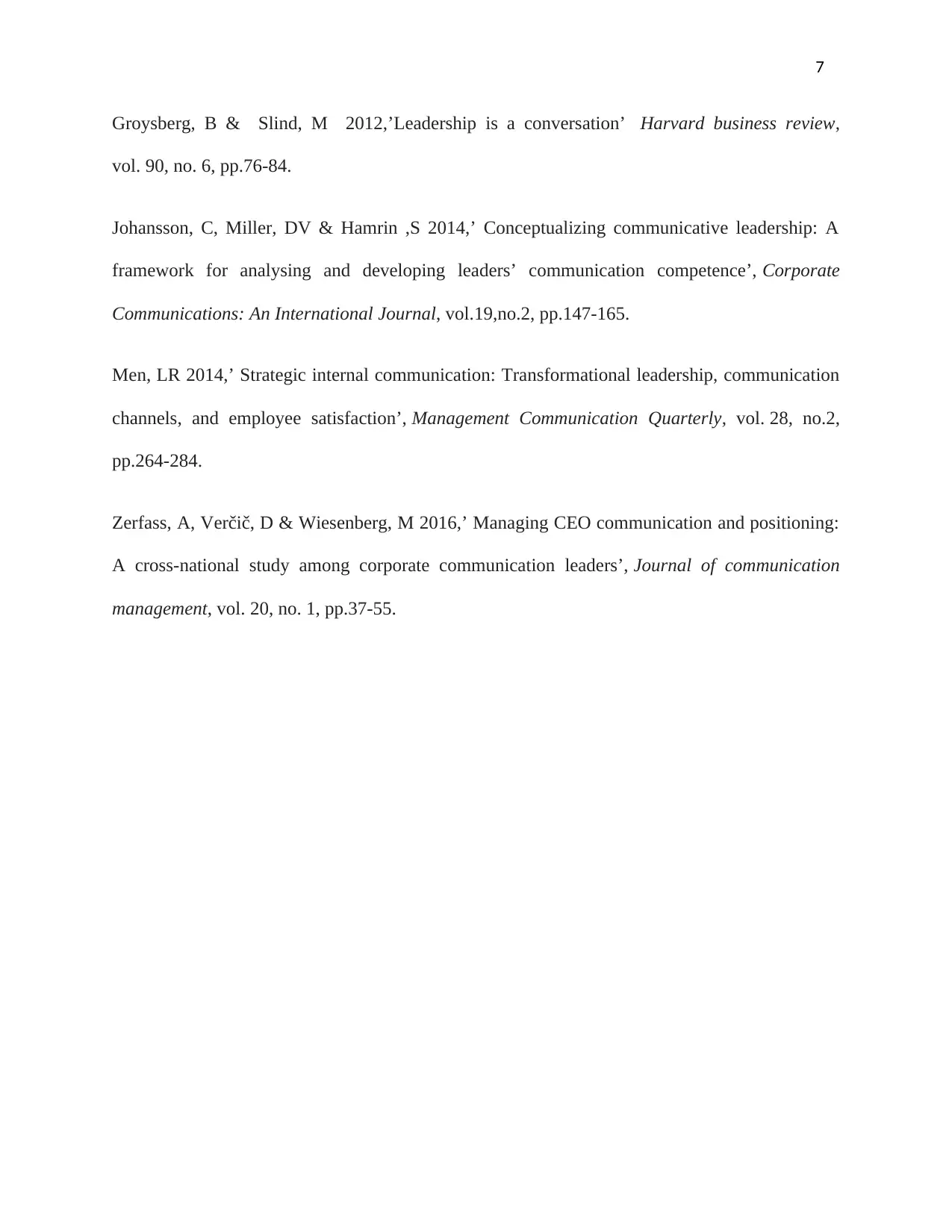
7
Groysberg, B & Slind, M 2012,’Leadership is a conversation’ Harvard business review,
vol. 90, no. 6, pp.76-84.
Johansson, C, Miller, DV & Hamrin ,S 2014,’ Conceptualizing communicative leadership: A
framework for analysing and developing leaders’ communication competence’, Corporate
Communications: An International Journal, vol.19,no.2, pp.147-165.
Men, LR 2014,’ Strategic internal communication: Transformational leadership, communication
channels, and employee satisfaction’, Management Communication Quarterly, vol. 28, no.2,
pp.264-284.
Zerfass, A, Verčič, D & Wiesenberg, M 2016,’ Managing CEO communication and positioning:
A cross-national study among corporate communication leaders’, Journal of communication
management, vol. 20, no. 1, pp.37-55.
Groysberg, B & Slind, M 2012,’Leadership is a conversation’ Harvard business review,
vol. 90, no. 6, pp.76-84.
Johansson, C, Miller, DV & Hamrin ,S 2014,’ Conceptualizing communicative leadership: A
framework for analysing and developing leaders’ communication competence’, Corporate
Communications: An International Journal, vol.19,no.2, pp.147-165.
Men, LR 2014,’ Strategic internal communication: Transformational leadership, communication
channels, and employee satisfaction’, Management Communication Quarterly, vol. 28, no.2,
pp.264-284.
Zerfass, A, Verčič, D & Wiesenberg, M 2016,’ Managing CEO communication and positioning:
A cross-national study among corporate communication leaders’, Journal of communication
management, vol. 20, no. 1, pp.37-55.
1 out of 8
Related Documents
Your All-in-One AI-Powered Toolkit for Academic Success.
+13062052269
info@desklib.com
Available 24*7 on WhatsApp / Email
![[object Object]](/_next/static/media/star-bottom.7253800d.svg)
Unlock your academic potential
Copyright © 2020–2025 A2Z Services. All Rights Reserved. Developed and managed by ZUCOL.

